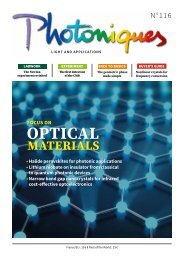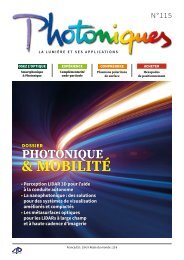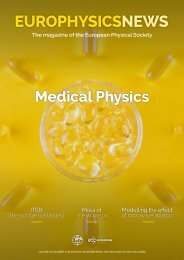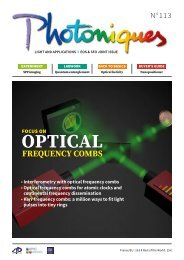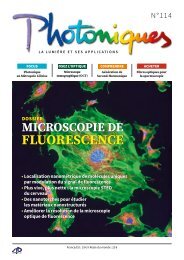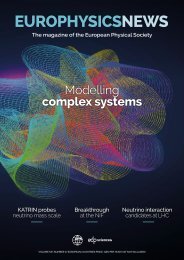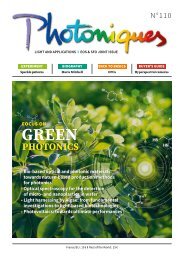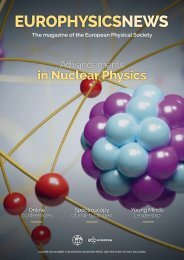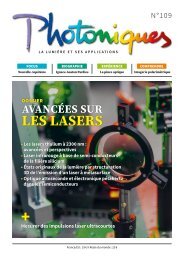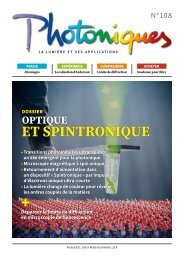Europhysics News 53-4
Europhysics News Quantum Issue
Europhysics News Quantum Issue
Create successful ePaper yourself
Turn your PDF publications into a flip-book with our unique Google optimized e-Paper software.
molecular motor<br />
FEATURES<br />
a mass of 26 Dalton (= 4.32e-26 kg). The motor self-assembles<br />
by exposing the PdGa surface to acetylene gas (at<br />
10e-9 mbar) at low temperatures (below 170 K). Figure 2b<br />
shows the scanning tunneling microscopy (STM) image<br />
of such a motor at 77 K. The three-lobed bright feature<br />
in the center shows a rotating acetylene molecule, where<br />
the rotation is much faster than the frame rate of the STM<br />
(about one frame per minute). This means the image represents<br />
a time average of the molecule in all its meta-stable<br />
rotation states as schematically shown on the right<br />
hand side of Fig. 2b).<br />
Only by reducing the temperature to 5 K, the rotation<br />
becomes slow enough for the STM to image the molecule<br />
in each of its 3 distinguishable rotational states (see. Fig.<br />
3a and 3b). One can see that from one frame to the other<br />
that the acetylene molecule rotates by 60° in the CCW<br />
direction with a bit of eccentricity.<br />
As the frame rate of STM is rather slow, we use a different<br />
mode of observation, which drastically increases<br />
the time resolution. As shown schematically in Fig. 3c,<br />
instead of constantly imaging the acetylene molecule, we<br />
'park' the tip of the STM at a certain position over the<br />
molecule. In the 'parking' mode, each rotation of the molecule<br />
changes the current between the tip and the sample.<br />
Figure 3d shows such a current-time diagram with the tip<br />
parked in the position denoted by the marker in rightmost<br />
image of Fig. 3a. This time series is characterized by<br />
3 distinct current levels (A, B and C), each corresponding<br />
to one rotational state of the rotor, and sudden transitions,<br />
i.e. jumps, between them. Based on the distance<br />
between the molecule and the tip, we can correlate the<br />
current levels with the rotational states observed in the<br />
STM topographies (see Fig. 3a). What is remarkable is<br />
that the sequence of rotational transitions from A to B to<br />
C and back to A, which corresponds to a 180° rotation, is<br />
maintained throughout the whole sequence of the 23 rotation-events,<br />
which implies unidirectional CCW motion<br />
of the rotor. Under the best conditions, the probability of<br />
a jump in the wrong direction is about 1%.<br />
As mentioned before, the rotation rate or rotation frequency<br />
is temperature dependent and Fig. 4a shows this<br />
dependency in more detail. From about 15 K onwards,<br />
we see that there is an exponential increase of the rotation<br />
frequency, from which we can deduce an energy barrier<br />
height between the rotation states of about 25 meV. We<br />
estimate that at 77 K (see Fig. 2b) the rotor spins faster<br />
than 100'000 times a second. All temperature induced<br />
rotations are, however, not directional. This is in accordance<br />
with the 2 nd law of thermodynamics. As we control<br />
temperature macroscopically, the stator, the rotor and the<br />
STM tip are in thermal equilibrium and a thermally activated,<br />
directional motion is impossible because it would<br />
decrease entropy.<br />
The rotation of the rotor, however, is not just activated<br />
by temperature; the tunneling current of the STM<br />
EPN <strong>53</strong>/4 25



